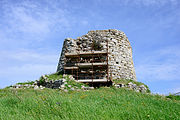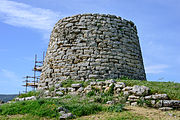Nuraghe Is Paras
Immediately north of the city of Isili in the province of Sud Sardegna in Sardinia is the Is Paras Nuraghe , a complex structure. The complex, made of white limestone , is considered one of the most beautiful on the island. Its central nuraghe has a tholos with an interior height of 11.8 m, which is one of the highest in Sardinian prehistoric times. 33 layers of stone, with a lower diameter of about 6.3 m, form a uniquely preserved cantilever dome under the otherwise rather incomplete tholoi of the nuraghi. Nuraghi are prehistoric and early historical towers of the Bonnanaro culture (2200–1600 BC) and the subsequent nuraghi culture (around 1600–400 BC) in Sardinia, which is inextricably linked with it .
The originally single central nuraghe no longer has an upper floor. It was probably much higher and was later enclosed by a triangular formation made up of (partially completely demolished) external towers, straight connecting walls and an inner courtyard. The system has a total size of 35.5 × 24 m. Excavations took place in 1975–1977 and most recently in 1998.
Access
The approximately 2.5 m long passage to the inner courtyard has a niche on the left, which leads to the narrow staircase leading upwards, by means of which the upper floors of the south-eastern outer tower can be reached. Opposite the stairwell, a little above floor level, there is a square niche, which is usually referred to as a guard cell.
- Nuraghe Is Paras
patio
The straight corridor leads through a rectangular door with an architrave into the courtyard, which has the shape of a three-quarter circle. Its dimensions are 3.65 m in width and 4.8 m in length. Its walls differ from those of the nuraghe in that they are made of small and medium-sized stones. The courtyard leads to the central nuraghi and the southeast tower.
Southeast tower
The tower stump examined first has an inner diameter of about 3.1 m and only two trapezoid wall slots in the 2 m wide outer wall.
The central tower or mastio
Access
The only completely preserved tower has a diameter of 12.5 m, and since its inner chamber is shifted on one side, wall thicknesses between 4.6 and 2.3 m. The south-facing entrance, 0.8 m above the courtyard, consists of a rectangular door that is 2.8 m high and 1.15 m wide. The corridor leading into the Tholos is 4.6 m long and has a trapezoidal floor plan. Its width is 1.15 m at the beginning and 2.05 m at the transition to the Tholos. It has a side niche on the right and its ceiling rises from 2.8 m to 5.75 m towards the Tholos.
The tholos
The slightly oval chamber with a diameter of 6.2 or 6.4 m, whose walls are made of large limestone blocks, completely lacks the usual side niches. It has an opening for this, which is called a well, although a natural water supply at this point can almost be ruled out. The opening of the well is 1.25 m in diameter, but then widens in the shape of a bell over several different heights to around 4.3 m. The excavation of the well unexpectedly revealed remarkable technical difficulties which resulted in the work being interrupted as the monument itself was in danger. At a height of 5.25, in the wall of the tholos, there is access to a staircase (which can probably be reached by means of a wooden structure), which leads to a platform on which there is a rectangular window. The spiral staircase then leads to the uneven (because at least partially removed) upper platform which still has a diameter of 11 m.
Excavation results
The central nuraghe was built before the 15th century BC. BC and belongs to the group of the oldest Tholosnuraghen. In the 13th or 12th century the courtyard and the southeast tower were added. Is Paras received its last extensions in the 11th century and was used for more than 1200 years until Roman times. A multi-phase use of the nuraghi was recognized below the Roman level. Well-made pottery with geometric decorations was found on the upper levels. There are bowls with handles, pear-shaped vases (in the Santa Anastasia style), leaf-shaped oil lamps, jugs with spouts and more. The pottery of the lower (older) levels is of a coarser nature. There are now pans and vases with thick rims. Bone pendants, loom weights , bronzes and a fragment of a small votive sword were also found. On the other hand, comb-decorated pottery from the final phase is completely absent.
Nearby is the fountain sanctuary of Santa Vittoria .
See also
literature
- Giovanni Lilliu : I nuraghi. Torri preistoriche di Sardegna. La Zattera, Cagliari 1962. pp. 166-168.
- A. Moravetti: Isili (Nuoro) Lo. Nuraghe Is Paras. In: I Sardi. 1985. p. 202 ff.
Web links
Coordinates: 39 ° 44 ′ 55 ″ N , 9 ° 6 ′ 27 ″ E





